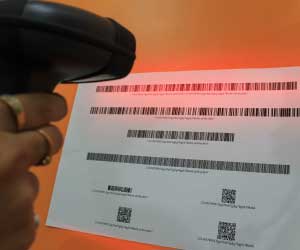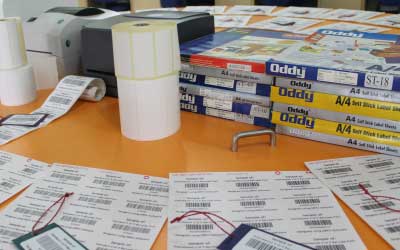Benefits of Automated Barcode Scanning Systems in Distribution
Automated barcode scanning systems can offer several benefits for distribution operations, including:

-
Increased Efficiency:
Barcode scanning systems can streamline the distribution process, allowing for faster and more accurate picking, packing, and shipping of products. This can lead to increased productivity, reduced errors, and lower labor costs.
-
Improved Inventory Management:
Barcode scanning systems can provide real-time inventory data, allowing distributors to monitor stock levels and make informed decisions about inventory replenishment and ordering.
-
Enhanced Tracking and Traceability:
Barcode scanning systems can provide end-to-end visibility of products throughout the distribution process, making it easier to track and trace products in the event of a recall or other issue.
-
Data Analytics:
Barcode scanning systems can generate valuable data on distribution operations, including order processing times, shipping times, and inventory levels, which can be used to identify areas for improvement and optimize distribution processes.
-
Improved Customer Service:
Barcode scanning systems can help ensure accurate and timely delivery of products, leading to improved customer satisfaction and loyalty.
Distribution Barcodes Help to Improve Efficiency And Accuracy in The Distribution Process
Barcodes play a significant role in improving efficiency and accuracy in the distribution process by providing an automated and standardized system for tracking and managing inventory. With barcodes, distribution workers can quickly scan the barcode labels on products and equipment to identify and track the item in real-time, reducing the risk of manual data entry errors.
Barcodes also provide real-time visibility into inventory levels and movements, helping distribution centers optimize their supply chain operations, reduce waste, and lower costs. With accurate and up-to-date inventory data, distribution centers can plan for restocking and replenishment, and ensure that they have the right products in stock when needed.
Moreover, barcodes help reduce the time and labor required for inventory tracking and management. By automating the process of tracking inventory, distribution centers can allocate their resources to other critical tasks, such as order processing and customer service. This helps improve overall efficiency, which translates into better customer satisfaction, and ultimately, increased revenue.
Distribution Workers Ensure The Accuracy and Quality of The Information Encoded in Barcodes
Distribution workers can take several steps to ensure the accuracy and quality of information encoded in barcodes, including:
1 Checking barcode labels: Workers should ensure that barcode labels are legible, scannable, and match the product or package they are attached to. They should also check for any damage or smudging on the label that could affect scanning accuracy.
2 Proper scanning: Workers should use appropriate barcode scanners to scan the labels and ensure that the information encoded in the barcode matches the product or package being handled. They should also check the scanned data against the information in their inventory management system.
3 Quality control checks: Workers should perform regular quality control checks on barcode labels and scanners to ensure they are functioning properly. They should also train employees on how to use barcode scanners correctly.
4 Barcoding procedures: Distribution centers should have proper barcoding procedures in place, including guidelines for creating and printing labels, as well as procedures for correcting errors or discrepancies.
5 Regular maintenance: Regular maintenance of barcode scanners, printers, and labels can help ensure accuracy and prevent malfunctions. This includes cleaning scanners, replacing worn-out labels, and calibrating equipment when necessary.
Conclusion: By following these steps, distribution workers can help ensure the accuracy and quality of information encoded in barcodes, which can improve the efficiency and accuracy of their operations.
Distribution Barcode Systems Help With Tracking And Managing Inventory
Distribution barcode systems help with tracking and managing inventory by providing a fast and accurate way to identify and record inventory items as they move through the distribution process. Each item is labeled with a unique barcode that contains important information about the item, such as its SKU number, product description, and location in the warehouse.
As items are received into the warehouse, they are scanned and the barcode information is recorded in the system. This allows the inventory database to be updated in real-time, ensuring accurate and up-to-date information is available to distribution staff. As items are picked and packed for shipment, they are scanned again to ensure that the correct items are being shipped to the correct destination.
Barcode systems can also help with inventory management by providing data on inventory levels, stock movement, and order fulfillment rates. This information can be used to optimize inventory levels, reduce waste, and improve customer satisfaction by ensuring that orders are fulfilled quickly and accurately.
Successful Distribution Barcode System Implementations Example
Distribution barcode system implementations have been successful in various industries, including retail, healthcare, manufacturing, and logistics. Here are a few examples and the benefits they have provided:
-
Retail Industry:
Target implemented a barcode system in their distribution centers to improve inventory management and order fulfillment. The barcode system allowed Target to track inventory levels in real-time, reduce out-of-stock situations, and improve order accuracy. This resulted in improved customer satisfaction and increased sales.
-
Healthcare Industry:
The healthcare industry has also seen benefits from barcode system implementation in distribution. For example, McKesson, implemented a barcode system to track and trace prescription drugs throughout the supply chain. This allowed McKesson to reduce drug counterfeiting and diversion, improve patient safety, and comply with regulatory requirements.
-
Manufacturing Industry:
The manufacturing industry has also seen benefits from distribution barcode system implementation. For example, Toyota implemented a barcode system in their distribution centers to improve the accuracy and speed of their order fulfillment process. The barcode system allowed Toyota to reduce errors, improve order accuracy, and increase productivity.
-
Logistics Industry:
The logistics industry barcode software has seen significant benefits from barcode system implementation in distribution. For example, DHL implemented a barcode system to track packages and streamline their delivery process. The barcode system allowed DHL to reduce errors, improve delivery times, and increase customer satisfaction.
Challenges Of Distribution Implementing Barcode Systems
Implementing barcode systems in distribution can provide several benefits such as improved inventory management, reduced errors, and increased efficiency. However, there are some common challenges associated with implementing barcode systems in distribution, which include:
-
Data Accuracy:
Barcode systems rely on accurate data, and errors in data can lead to errors in the system. To address this issue, it is important to ensure that the data is accurate and up-to-date, and that the barcode system is well-integrated with other systems such as inventory management systems or enterprise resource planning (ERP) systems.
-
System Integration:
Barcode systems may need to be integrated with existing systems such as inventory management systems or ERP systems.
-
Cost:
Implementing barcode systems can be expensive, especially for small businesses. To address this issue, it is important to evaluate the benefits and costs of the system and determine if it is cost-effective.
In summary, implementing barcode systems in distribution can provide several benefits but can also be challenging. Addressing these challenges requires a comprehensive approach that involves ensuring barcode quality, data accuracy, staff training, environment, labeling materials, system integration, and evaluating costs.
While the initial investment in a distribution barcode system may be significant, the long-term benefits can be significant as well. By improving accuracy and efficiency, distribution centers can save money on labor costs, reduce the likelihood of costly errors or delays, and improve the overall efficiency of distribution processes. Ultimately, the decision to implement a distribution barcode system will depend on the specific needs and budget of each facility, but the benefits can often outweigh the costs.
